Discovered by Pan-STARRS (F51) MPC designation 2015 TB145 Discovered 10 October 2015 Earth moid 0.2 cm Discoverer Pan-STARRS | Discovery date 10 October 2015 Observation arc 22 days Rotation period 5 hours Absolute magnitude 20 Asteroid group Apollo asteroid | |
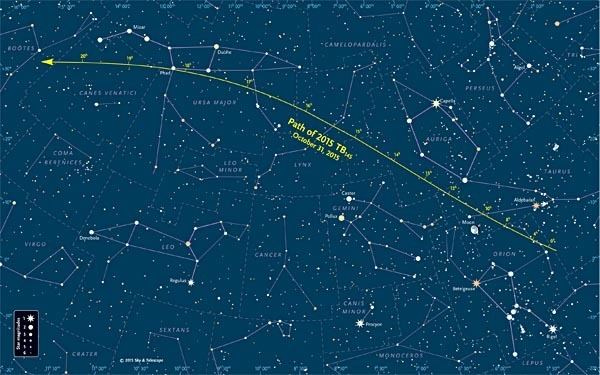 | ||
Minor planet category Apollo
NEO, PHA,
Mercury-crosser asteroid,
Venus-crosser asteroid,
Mars-crosser asteroid Aphelion 3.9076 AU (584.57 Gm) (Q) Similar Pan-STARRS discoveries, Other celestial objects | ||
2015 TB145 (also written 2015 TB145) is an Apollo near-Earth asteroid roughly 600 meters (2,000 feet) in diameter. It safely passed 1.27 lunar distances from Earth on 31 October 2015 at 17:01 UTC.
Contents
- Asteroid 2015 tb145 will pass close to earth on halloween
- 2015 flyby
- Radar imagery
- Possible cometary origin
- References
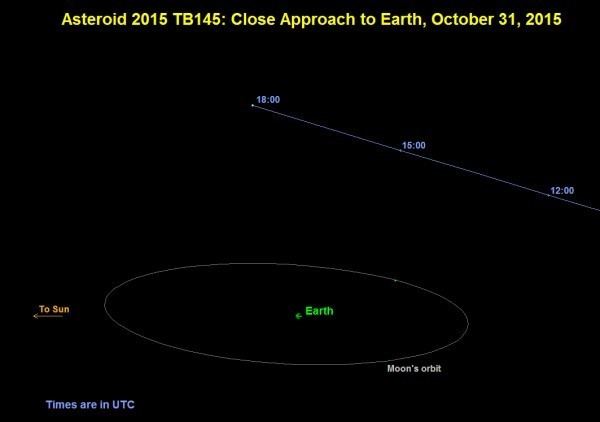
The asteroid was first observed on 10 October 2015 by Pan-STARRS at an apparent magnitude of 20 using a 1.8-meter (71 in) Ritchey–Chrétien telescope. The asteroid was not discovered sooner because it spends most of its time beyond the orbit of Mars, has a large orbital inclination, and spends most of its time well below the plane of the ecliptic. The asteroid last passed within 0.064 AU (9,600,000 km; 5,900,000 mi) of Earth on 29 October 1923 and will not pass that close again until 1 November 2088. The 2015 flyby was its closest approach to Earth in at least the next 500 years.
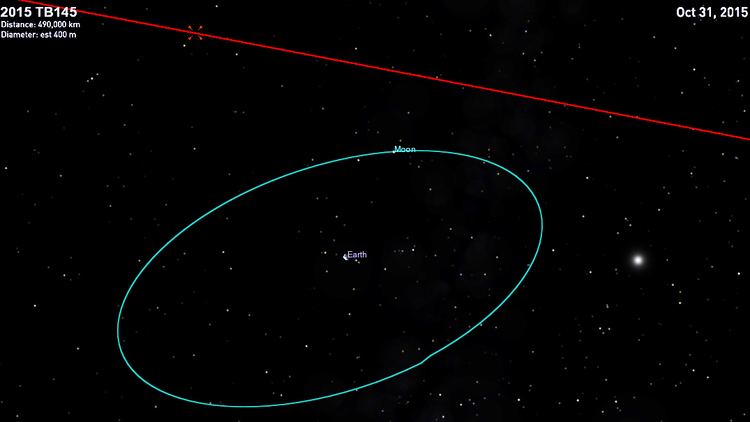
The media has nicknamed the asteroid the "Great Pumpkin" after the animated Halloween television special It's the Great Pumpkin, Charlie Brown, "Spooky", the “Halloween Asteroid”, and the “Skull Asteroid” due to its human skull-like appearance following radio frequency images taken at Arecibo Observatory.

Asteroid 2015 tb145 will pass close to earth on halloween
2015 flyby
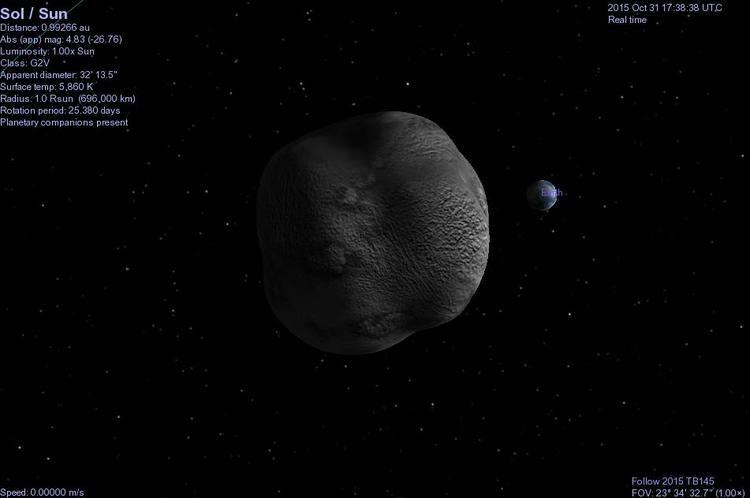
On 31 October 2015 the asteroid passed 0.00191 AU (286,000 km; 178,000 mi) from the Moon and then passed 0.00325 AU (486,000 km; 302,000 mi) from Earth.

The last approach this close by an object (with absolute magnitude < 20) was 2004 XP14 on 3 July 2006 at 1.1 lunar distances. The next object this large known to pass this close to Earth is (137108) 1999 AN10 that will pass about 1 lunar distance from Earth on 7 August 2027. It is estimated that there are about 2400 near-Earth asteroids 300–500 meters in diameter, of which about 1100 have been discovered.
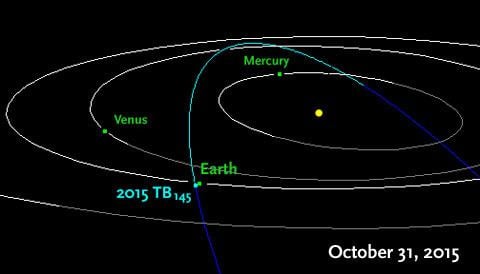
During closest approach to Earth the asteroid reached about apparent magnitude 10, which is much too faint to be seen by the naked eye. Even at peak brightness, the asteroid was a challenging target for amateur astronomers with small telescopes, best seen in the Northern hemisphere. The glare from an 80% waning gibbous Moon also hindered observations.
At 11:00 UT the asteroid was in the constellation of Taurus about 9 degrees from the Moon and moving at a rate of 3.4 degrees per hour. At the time of closest approach of 17:00 UT the asteroid was in the constellation of Ursa Major about 56 degrees from the Moon and moving at a rate of 14.7 degrees per hour. After closest approach it quickly became too faint and too close to the Sun in the sky to be seen.
Radar imagery
The close approach was studied with radar using Goldstone, the Green Bank Telescope, and the Arecibo Observatory. It was one of the best radar targets of the year with a resolution as high as 2 meters (7 ft) per pixel. Bistatic radar images created with the Green Bank Telescope had a resolution of 4 meters (13 ft) per pixel. Arecibo images had a resolution of 7.5 meters (25 ft) per pixel.
Possible cometary origin
The high orbital inclination and eccentricity suggest 2015 TB145 may be an extinct comet that has shed its volatiles after numerous passes around the Sun. Orbital calculations by Petrus Jenniskens and Jérémie Vaubaillon show that it is not expected to produce associated meteors in 2015. Meteoroids should pass more than 0.0007 AU (100,000 km; 65,000 mi) from Earth's orbit. If meteoroids do cross Earth's path, the radiant should be Northern Eridanus. Cameras for Allsky Meteor Surveillance (CAMS) did not detect any activity in the presumed area of the sky during 2013 and 2014. The object has a low albedo of 0.06, which is only slightly more than a typical comet that has an albedo of 0.03-0.05.
